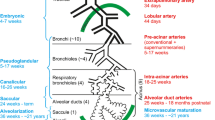Summary
-
1.
According to previous results of experiments concerning pulmonates the inferior epithelium of the radular gland has been found responsible for the continuous and mouthwards directed transport of new radular teeth. The motion of the epithelial cells, also directed towards the mouth, provides for the carriage. The structural basis of the transport mechanism is thus recorded according to light and electron microscopical studies on the slugLimax flavus L.
-
2.
Close to the collostylar hood the inferior epithelium secretes the subradular membrane which extends under the anterior part of the radula and consists of thin layers. Rupture artifacts reveal that this has a tough or rigid consistence and is connected both to the radular membrane, which lies above it as to the inferior epithelium.
-
3.
In the posterior part of the radular gland the cells of the inferior epithelium show a plane, thickly matted edge of microvillis. Microvillis however lack the cells in the anterior part of the radular gland. From about the collostylar hood the cells are inter-locked with the subradular membrane by means of strong apical projections.
-
4.
As a result of intensive interdigitation with the inferior epithelium the radula is carried at the same rate as the cells, underlying the subradular membrane move forward. Within the radular gland the radula most likely glides over the apical cell area.
Zusammenfassung
-
1.
Nach bisherigen experimentellen Befunden an Lungenschnecken ist das Unterepithel der Radulascheide für den kontinuierlichen, mundwärts gerichteten Transport neuer Radulazähne verantwortlich. Die ebenfalls mundwärts gerichtete Wanderbewegung der Unterepithelzellen liefert den Transportantrieb. Die strukturellen Voraussetzungen des Transportmechanismus werden nach licht- und elektronenoptischen Untersuchungen an der NacktschneckeLimax flavus L. beschrieben.
-
2.
Etwa auf der Höhe der Sperrkutikula sezerniert das Unterepithel die aus dünnen Schichten bestehende Subradularmembran, die unter dem gesamten vorderen Radulateil liegt. Sie hat, nach Zerreißungsartefakten zu urteilen, eine zähe oder feste Konsistenz und ist sowohl mit der über ihr liegenden Radulamembran als auch mit dem Unterepithel verbunden.
-
3.
Im hinteren Scheidenteil besitzen die Unterepithelzellen einen ebenen, dichtverfilzten Mikrovillisaum, der im vorderen Scheidenbereich fehlt. Etwa ab Höhe der Sperrkutikula sind die Unterepithelzellen mittels kräftiger Apikalfortsätze mit der Sub-radularmembran verzahnt.
-
4.
Infolge der intensiven Verzahnung mit dem Unterepithel wird die Radula mit derselben] Geschwindigkeit transportiert, mit der sich die im Bereich der Subradular-membran liegenden Epithelzellen vorwärtsbewegen.
Similar content being viewed by others
Abbreviations
- bL:
-
basales Labyrinth
- Bm:
-
Basalmembran
- Bs:
-
Bindegewebshülle
- Ep:
-
Ergastoplasma
- F:
-
Fibrozyt
- Mh:
-
Mundhöhle
- Mv:
-
Mikrovilli
- O:
-
Odontoblasten
- Oep:
-
Oberepithel
- Oes:
-
Oesophagus
- Rm:
-
Radulamembran
- Rp:
-
Radulapolster
- Sp:
-
Sperrkutikula
- Sub:
-
Subradularmembran
- Uep:
-
Unterepithel
Literatur
Hoffmann, H.: Über die Radulabildung beiLimnaea stagnalis. Jena. Z. Naturw.67, (N. F. 60) 535–550 (1932)
Isarankura, K., Runham, N.W.: Studies on the replacement of the gastropod radula. Malacol.7 (1), 71–91 (1968)
Kerth, K.: Radulaersatz und Zellproliferation in der röntgenbestrahlten Radulascheide der Nackt-schneckeLimax flavus L. Ergebnisse zur Arbeitsteilung der Scheidengewebe. Wilhelm Roux' Archiv172, 317–348 (1973)
Kerth, K., Krause, G.: Untersuchungen mittels Röntgenbestrahlung über den Radula-Ersatz der NacktschneckeLimax flavus L. Wilhelm Roux' Archiv164, 48–822 (1969)
Märkel, K.: Bau und Funktion der Pulmonaten-Radula. Z. wiss. Zool.160, 213–289 (1958)
Runham, N.W.: A study of the replacement mechanism of the pulmonate radula. Quart. J. micr. Sci.104, 271–277 (1963)
Runham, N.W.: Alimentary canal. In: Pulmonates, Vol. I (V. Fretter, J. Peake, eds.), pp. 53–104. London-New York-San Francisco: Academic Press 1975
Wohlfarth-Bottermann, K.E.: Die Kontrastierung tierischer Zellen und Gewebe im Rahmen ihrer elektronenmikroskopischen Untersuchungen an ultradünnen Schnitten. Naturwiss.44, 287–288 (1957)
Author information
Authors and Affiliations
Rights and permissions
About this article
Cite this article
Kerth, K. Licht- und elektronenoptische Befunde zum Radulatransport bei der LungenschneckeLimax flavus L. (Gastropoda, Stylommatophora). Zoomorphologie 83, 271–281 (1976). https://doi.org/10.1007/BF00993513
Received:
Issue Date:
DOI: https://doi.org/10.1007/BF00993513




